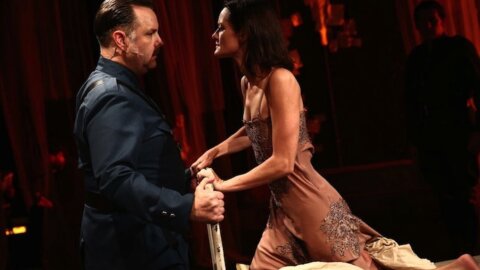Mata Hari’s reputation as dancer spy has inspired plenty of retellings in film, literature, and a recent full-length ballet. The PROTOTYPE festival, which began showcasing hybrid theatrical compositions in 2013, and the HERE residency program gave composer Matt Marks and librettist Peter Peers a platform to premiere an opera-theater version. In the opening scene Mata Hari is stripped of her exotic costume and left in a bare slip, setting the tone for a modern deconstruction of self-invented celebrity.
The famous Dutch heroine was born in 1876 and took two children, syphilis, and worldly knowledge from an abusive first husband, sung by Steve Hrycelak. She escaped to Paris as a divorcee, developed an international network of lovers through exotic dancing, and was executed in 1917 for questionable treason. Peers’ libretto, however, saw her infamous exploits as extreme measures to protect herself and pursue true love. Tina Mitchell anchored the piece in her spoken-only role as Mata Hari, unwinding her story shortly before her execution through a series of flashbacks. Her resilience through abuse, the struggle for true love, and deep guilt as a failed mother transformed the guard, a cursing nun played by Mary Mackenzie, into sympathetic confidante and a redemptive undercurrent of the piece.

Five strong male voices were featured and only one female singer, but Mitchell’s commanding performance gave Mata Hari the ultimate say against male domination. Tomás Cruz as Mata Hari’s true love gave the most memorable vocal performance, singing a piercing pop falsetto, and Jeffrey Gavett, Daniel Neer, and Joshua Jeremiah were militant bel canto voices. One vocal moment in the finale highlighted the potential of opera-theater as a medium. Preparing to face her firing squad, Mata Hari and her prison guard sang and spoke the same unison words in a climactic chant-song duet. The nun, standing behind the heroine, seemed like the singing private shadow of the dancer’s spoken public self; Mata Hari fell silent, and the music and dance become her voice as the nun soars Mata Hari’s final moments of pensive choreography.
In some ways, the fragmented score deconstructed Mata Hari herself and was her musical expression in place of a singing role. The constant shuffle of musical styles reflected her displacement, complex character, and shifting memories. Still, the score lacked direction and struggled to keep pace with Peers’ dense, ambitious libretto. It underscored the theater well, but didn’t emerge as its own dramatic agent, too reliant on volume and frantic violin to sustain tension. Choral humming, extended violin technique, and bared electric guitar made repeated appearances as dramatic devices; everyone was amplified. David Bloom conducted a solid, spry band of accordion, electric guitar, violin, piano, and electronics whose unique instrumentation seemed a missed opportunity for more. But if Marks’ music developed too little, Peers’ libretto contained too much. The flashbacks flowed smoothly using sliding lace curtains between episodes, but ninety minutes without intermission needed refined scope as much as it needed less volume.

Dance helped to focus and drive the music-theater; the piece’s most dramatic moments were choreographed dialogue underscored by a loud, frantic band. The dance numbers provided visceral illustrations of how men dominated her body and gave Marks a chance to explore tango, waltz, and rock ballade. Mata Hari’s prowess as a dancer became the crux of the work: after divulging her deepest grief, her jailer confidante encourages her to have a final dance of defiant expression. Mata Hari’s taut movements wrapped in hanging tulle were somewhat unfulfilling as a dramatic climax, but the evolution of her dance from exuberance to male domination to self-possession was a strong and interesting theatrical choice. The piece ended the same way it began, with Mata Hari encircled by men; this time, we know she countered their threat boldly. The show excelled at peeling away layers of myth to get at basic humanity, afforded the famous heroine dignity beyond an expose, and showed the possibilities of opera-theater ripe for exploration.
























